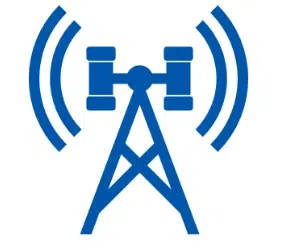Cell towers use various types of antennas to transmit and receive wireless signals to and from mobile devices. The choice of antenna type depends on factors such as the frequency bands used, the tower’s location, the desired coverage area, and the technology generation (e.g., 3G, 4G, 5G). Here are some common types of antennas used on cell towers:
- Omni-Directional Antennas: Omni-directional antennas radiate signals in all directions horizontally, providing 360-degree coverage. They are often used for broad coverage in urban, suburban, or rural areas where signals need to reach users in all directions.
- Directional Antennas: Directional antennas focus their signal in a specific direction or sector. They are commonly used in urban and suburban areas to provide targeted coverage in high-traffic areas or along highways. Panel antennas and sector antennas fall under this category.
- Panel Antennas: Panel antennas are rectangular or square and are typically mounted on the sides of a cell tower or a tower sector. They provide directional coverage and are used in specific sectors to serve a concentrated area.
- Sector Antennas: Sector antennas are larger antennas that cover a wider sector of the area around the tower. They are often used in high-density urban areas to provide coverage over a larger area while still focusing the signal.
- Parabolic Dish Antennas: These antennas are used for long-distance point-to-point communication or backhaul links between cell towers. They have a dish-shaped reflector that focuses the signal toward a specific receiver.
- MIMO (Multiple-Input, Multiple-Output) Antennas: MIMO technology uses multiple antennas at both the cell tower and the user device to improve data throughput and signal quality. MIMO antennas come in various configurations, such as 2×2, 4×4, or 8×8, depending on the number of transmit and receive elements.
- Small Cell Antennas: Small cell antennas are used in urban areas to increase capacity and provide coverage in high-traffic locations. They are smaller and less obtrusive than traditional tower antennas and are often mounted on utility poles or buildings.
- DAS (Distributed Antenna System) Antennas: DAS antennas are used in indoor or in-building wireless systems to provide coverage in large venues like stadiums, shopping malls, airports, and office buildings. They are connected to a centralized base station.
- Cross-Polarized Antennas: Cross-polarized antennas are designed to transmit and receive signals with different polarizations (e.g., horizontal and vertical). They can help reduce interference and improve signal quality.
- Dual-Band and Multi-Band Antennas: These antennas are designed to support multiple frequency bands (e.g., 700 MHz, 2.4 GHz, 5 GHz) or multiple technologies (e.g., 4G and 5G) from a single antenna, reducing the need for multiple antennas on a tower.
The specific antennas used on a cell tower depend on the network’s requirements, coverage objectives, and the equipment installed by the wireless carrier. As technology evolves, cell towers may be equipped with a mix of antennas to support various frequency bands and wireless standards, including 3G, 4G, and 5G.
